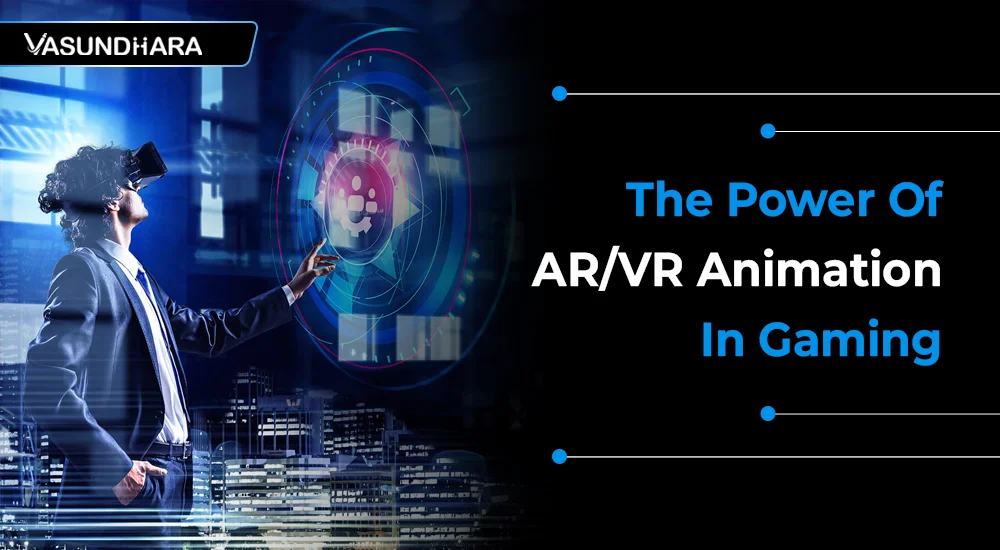The Power Of AR/VR Animation In Gaming


- Jan 15, 2024
The introduction of AR/VR animation has brought about a revolutionary change in the gaming industry.
Not only has this revolutionary technology changed the way we play games, but it has also created new opportunities for immersive experiences.
At the vanguard of cutting-edge technologies that bring digital experiences to life are animations for AR (Augmented Reality) and VR (Virtual Reality).
While virtual reality immerses viewers in a fully simulated environment, augmented reality superimposes digital content onto the real world to enhance the over-the-real impression of reality.
These technologies have the power to completely change how we interact with virtual environments when they are used in gaming.
This article delves into the intricacies of AR/VR game development, examining its importance in the gaming sector, charting its development, and comprehending its influence on the gaming encounter.
The origins of gaming animation can be traced back to the 1970s, when arcade games utilized pixelated sprites.
Advancements resulted in the 8-bit and 16-bit eras, which introduced more intricate graphics. Attaining 3D technology in the mid-1990s was a turning point.
Presently, gaming has been transformed by the advent of AR/VR in gaming, and virtual reality has been advancing over the past decade to produce immersive environments.
Prominent examples of augmented reality include smartphone applications such as "Pokémon GO," which seamlessly integrate digital and physical components.
This dynamic evolution exemplifies the industry's ongoing ability to adjust to revolutionary technologies, holding the potential for a bright future filled with gaming experiences that are even more immersive and captivating.
Virtual Reality (VR) and Augmented Reality (AR) have progressed from their early roles in technology demonstrations to become disruptive forces in the game business.
AR/VR animation, a critical component of this progression, has completely transformed how players interact with digital surroundings.
Let's look at the unique features, immersive potentials, and technological developments that define AR/VR animation
The player experience has been fundamentally transformed with the introduction of transformative elements that redefine immersion, narrative, and gameplay mechanics through the incorporation of AR/VR animation into video games.
Immersive Experiences: AR/VR animation effectively realizes the complexities of character movements through the im
plementation of cutting-edge motion-capture technologies.
Realistic elements contribute to maximizing player retention with stunning animation effects through the provision of authentic in-game experiences.
Dynamic Environments: In response to player actions, environments become dynamic and responsive.
The enhanced level of immersion created by this vitality renders virtual environments more tangible and alive.
Interactive Narratives: AR/VR animation empowers interactive storytelling, where player choices influence the narrative's direction.
This branching approach enhances player agency, creating a personalized and engaging storytelling experience.
Emotional Engagement through Animation: Lifelike animations evoke genuine emotions, fostering a deeper connection between players and game characters.
Emotional engagement becomes a pivotal aspect, enhancing the overall narrative impact.
User Interaction Improvements: AR/VR animation revolutionizes user interactions through gesture-based controls, haptic feedback, and spatial awareness.
Players experience a heightened level of control and responsiveness, breaking traditional interaction barriers.
Innovative Game Design Possibilities: Developers explore innovative game designs, from augmented reality puzzle-solving to fully immersive virtual worlds.
AR/VR animation opens doors to creative possibilities, pushing the boundaries of traditional gaming animation trends.
The gaming industry has been profoundly impacted by AR/VR animation, which has revolutionized the way in which players interact with digital domains.
An analysis of prominent video games and their effective integrations offers valuable insights into the wide range of uses and player experiences that AR/VR animation can facilitate.
In Superhot VR game, a first-person shooter leveraging VR animation for its unique time-based mechanic.
The slow-motion effect, synchronized with player movements, exemplifies how AR/VR animation transcends traditional genres.
No Man’s Sky VR game pioneers the integration of VR animation in an expansive, procedurally generated universe.
The ability to seamlessly transition between space exploration and planetary surfaces showcases the boundary-pushing potential of AR/VR animation.
Accubow AR is the world's first virtual archery app developed by Vasundhara Infotech.
This AR archery game is a single-player and multiplayer AR archery game. Players use a bow and arrow and try to score as high as possible by landing shots on a bullseye target in front of them.
Vasundhara Game Studios recently got featured by Google Play as part of its #WeArePlay campaign.
The progression of AR/VR animation in the gaming industry is marked by a myriad of obstacles and promising opportunities, as technological boundaries are expanded and the sector strives for wider acceptance.
The effective implementation of AR/VR animation presents difficulties in attaining a cohesive integration with a wide range of hardware and software ecosystems.
Ensuring a consistent and immersive experience across platforms necessitates that developers adeptly navigate compatibility issues.
Hardware constraints and latency are examples of technical obstacles that can hinder the fluidity of AR/VR animation.
Ongoing challenges in resource-intensive processes and the attainment of low-latency interactions necessitate the development of innovative solutions.
Adoption is hindered by the expense of virtual reality hardware, restricted availability, and apprehensions regarding motion nausea.
To surmount these obstacles, it is imperative to tackle the issues of affordability, enhance accessibility, and optimize user convenience in the context of AR/VR environments.
Expanded adoption requires deliberate and calculated endeavors to enlighten consumers, diminish obstacles to entry, and foster cooperation among sectors.
By fostering community engagement and partnerships, an AR/VR ecosystem can become more inclusive.
Promising advancements are expected to encompass more sophisticated motion-captARe technologies, enhanced haptic feedback, and improved AI-powered animations.
These advancements hold the potential to enhance the realism and responsiveness of animation experiences in AR/VR.
The incorporation of augmented reality into the gaming industry will facilitate mixed reality experiences in the future.
Furthermore, emergent technologies such as AR/VR convergence and the development of social VR spaces are expected to significantly influence the future of gaming animation.
With the ongoing transformation of the gaming industry, AR/VR animation has a significant impact on the future landscape.
The impact of this phenomenon transcends conventional gaming experiences, as it fosters cross-industry collaborations and influences game design.
AR/VR animation is anticipated to have a significant impact on the future of gaming.
The convergence of technologies will further blur the line between reality and virtual worlds, resulting in gaming environments that are more immersive and realistic.
Beyond visuals, augmented reality and virtual reality have a profound impact on the way in which participants engage, experience narratives, and contribute to virtual communities.
The next generation of AR/VR animation games promises to be exciting. Speculations include games with AI-driven narratives that dynamically respond to player choices, delivering a hitherto uncharted level of personalized storytelling.
It is envisaged that multiplayer experiences will grow into shared virtual places, boosting social relationships in immersive surroundings.
The future of gaming experiences goes beyond typical games, with virtual concerts, interactive storytelling, and collaborative virtual workspaces becoming commonplace.
The borders between reality and the virtual world will continue to blur as AR/VR animation progresses, providing consumers with a wide and immersive assortment of gaming and entertainment experiences.
Consider partnering with Request for quotes now.
As we conclude this exploration of AR/VR animation in gaming, it's crucial to recap its transformative power.
AR/VR game development has significantly propelled the progression of gaming experiences by effectively transforming gameplay mechanics and augmenting realism and immersion.
With the continuous progression of technology and the surmounting of obstacles, the forthcoming era holds the potential for unparalleled innovation, cooperation, and immersive gaming encounters.
Vasundhara Infotech, as a leading AR/VR game animation development studio, plays a pivotal role in shaping the future of gaming.
By leveraging their expertise in AR/VR animation technologies, they create groundbreaking gaming experiences that captivate audiences and push the boundaries of what is possible.
Whether you are a developer looking to incorporate immersive technologies into your games or a gamer eager to experience the next wave of transformative gaming, Vasundhara Infotech is your AR partner in creating the future of gaming.
Get in touch with us with our animation experts now.
Copyright © 2026 Vasundhara Infotech. All Rights Reserved.
